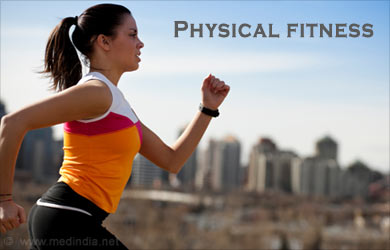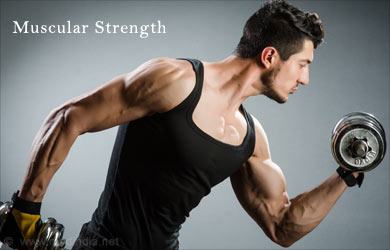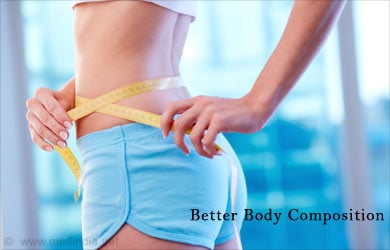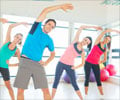- Physical activity, exercise, and physical fitness: definitions and distinctions for health-related research. - (http://www.ncbi.nlm.nih.gov/pmc/articles/pmc1424733/?page=5)
- Global recommendations on physical activity for health - (http://whqlibdoc.who.int/publications/2010/9789241599979_eng.pdf)
What are the Components of Physical Fitness?
Body – building for men and attaining size zero for women is the recent trend that many look up to and few strive to achieve it. The idea of what we put into making our body look fabulous matters the most. Unless a person is able to cope the physical strain that the body undergoes, it does not have meaning to a well-toned body.
So, what matters the most? Fitness! The ability of the body to perform a particular task, which involves physical work, is fitness.

What does it mean to be fit?
Fitness, physical activity and health go hand in hand. A physically fit person involves in some sort of physical activity apart from their daily routine.
Physical fitness is the ability of the body to carry out daily tasks with dynamism and alertness without undue fatigue. Also, fitness is the energy to enjoy leisure-time pursuits and to meet unforeseen emergencies. Indulging in physical activity is a means to attain physical fitness.
Physical activity may be as simple as a ten-minute brisk walk or a jog while taking the dog for a stroll. Doing some physical activity is better than nothing. The benefits of physical activity increase as the amount and intensity of the activity increases.
Health based and skill based fitness are the two main categories of Physical fitness.
- The ability of the heart, lungs, muscles and joints to perform well means that a person is fit. Regular physical activity improves physical fitness.
- Fitness based on skill, is the ability to perform skills used in sports and physical activities. They are helpful in performing in sports and games.
Components of Health Based Physical Fitness
Health-based components help you maintain good health. Your body systems, like the cardiovascular, the respiratory, and the muscular systems, all work together.
There are five components of Health-based Fitness
- Cardiovascular Endurance: The measure of the body’s ability to deliver oxygen and nutrients to its tissues and to transport waste out of the body is cardiovascular endurance. Exercises that challenge this component are called aerobic.
Aerobic exercise uses large muscle groups to increase heart rate. This causes faster and deeper breathing that maximizes the oxygen in the blood. Running, cycling, swimming, brisk walking, playing basketball, playing tennis are ways to increase cardiovascular endurance.
- Muscular Strength: The body’s power to use its own weight for force is muscular strength. Strength can be increased through anaerobic exercises such as weight lifting, weight bearing, and resistance. Those activities can also help maintain muscles during weight loss.

- Muscular Endurance: The ability of a muscle to exert itself and remain active for a long period of time, as well as its ability to resist, withstand, recover from, and have immunity to trauma, wounds, or fatigue is Endurance. Building endurance also helps prevent injury.
Running, swimming, and weightlifting are means by which muscular endurance can be increased.
- Flexibility is the ability of the joints to move freely. It also refers to the mobility of muscles, which allows for more movement around the joints of motion.
While aerobic and strength-training exercises allow muscles to contract and flex, muscles also need to be stretched to protect them from injury and to improve range of motion in the joints. And a person can be aerobically fit yet have poor balance.
Flexibility and balance training also sustain good skeletal posture.
Stretching, gymnastics, yoga are examples of exercises to increase flexibility.
- Body Composition is the percentage of fat, bone, water and muscle in human bodies. The ratio of the body’s lean mass of muscle, bone, vital tissue, and organs to its ratio of fat mass is a measure of fitness. Muscular tissue takes up less space in our body than fat tissue so body composition, as well as weight, determines leanness.
Benefits of Health Related Physical Fitness
Stamina, strength, speed and ideal body weight are scales by which the fitness of an individual can be assessed. The idea of fitness is that, it covers the overall physical ability of a person to do any form of activity. Building muscles is as important as being able to walk a couple of kilometres. The benefits of being physically fit are listed below:
- Improved Performance of Physical Activities: A person with a moderate to high level of muscular strength and endurance can perform everyday tasks such as climbing stairs and carrying groceries with ease as the oxygen consumption is maximal.
- Injury prevention: Good muscle strength and, particularly, endurance in the abdomen, hips, lower back, and legs, maintain the spine in proper alignment and help prevent low-back pain, which afflicts more than 85% of Americans at some point of time in their lives.
- Improved muscle and bone health with aging: Research has shown that good muscular strength helps people live healthier lives. A lifelong program of regular strength training prevents muscle and nerve degeneration that can compromise the quality of life and increase the risk of hip fractures and other potentially life-threatening injuries.
- Strength training and endurance training lead to an enhanced self-image in both men and women by providing stronger, firmer-looking muscles and a toned, healthy-looking body.
- Improved body composition: Ideal body weight imparts benefits on overall well being of an individual. The proportion of fat, muscle and lean mass determines the risk for you to be prone to obesity, high cholesterol levels, heart problems, diabetes and cancer. Increasing muscle mass by strength training helps to maintain a proportionate body composition.

Is there a connection between mortality and physical inactivity?
Of course! The drawbacks for a physically inactive life include, fatigue, susceptibility to gain weight resulting in the risk of developing non-communicable diseases.
World Health Organization (WHO) has estimated that physical inactivity is the fourth-leading risk factor for global mortality and the reason for approximately 3.2 million deaths per year.
Recent analysis has suggested that half an hour to one hour of physical activity reduced the risk of mortality by 19 percent and 24 percent respectively, and 31 percent lower risk in active individuals.
As we know that the benefits outweigh the risks, let us look forward to take an effort for a physically fit and healthier life.








